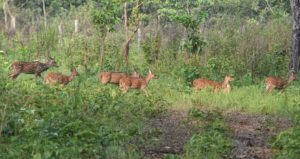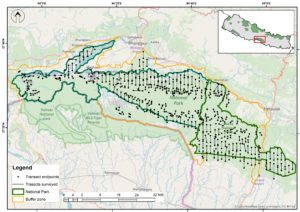How are our tigers in Chitwan-Parsa complex?
Nepal has managed to nearly double its tiger population in the last ten years – an amazing feat in tiger conservation. However, as the tiger habitat is limited primarily to the protected areas, increasing tiger population leaves us with two major concerns – how will the current setup of protected areas accommodate the increased tiger population and how will it impact Human-Tiger Conflict (HTC)?

Chital © ZSL
To find a solution, Ecological Carrying Capacity (ECC) for tigers must be estimated, so that we can manage and conserve optimum numbers of tigers while reducing human-tiger conflicts over the longer term. Tigers, the largest of the cat species, prey almost exclusively on large ungulates – hoofed mammals. Like with all carnivores, food resources tend to limit the tiger density. Subsequently, its ECC is also dependent on the ungulate biomass. The ECC for any animal is defined as the maximum number of animals of a given population that a specific area can support in terms of resources.
Chitwan National Park (CNP) has always been a high-density tiger source site with 40% of all tigers in Nepal inhabiting this park. Parsa National Park (PNP) – a park contiguous to CNP, on the other hand, is a low-density tiger site. However, it has seen an increase in tigers in recent years. Currently, the Chitwan-Parsa complex, part of the broader Chitwan-Parsa-Valmiki complex, supports an estimated 111 tigers, with CNP and PNP harbouring 93 and 18 tigers respectively.

Transects survey
The Department of National Parks and Wildlife Conservation (DNPWC) of Nepal, assisted by National Trust for Nature Conservation (NTNC) and Zoological Society of London (ZSL), initiated a study to estimate the ECC of Chitwan-Parsa Complex for the tiger. Field surveys were conducted to estimate the tiger prey base density of Chitwan-Parsa Complex during 29th April-25th May 2019. Ten survey teams were deployed from six different locations in the complex to complete surveys in 317 transects. Transects of length 3 km were laid out in north-south orientation in the plains while transects of variable lengths of 0.5-2 km were laid out in the Churia hills. Altogether, nine major prey species of tigers were recorded. However, the data from this survey is being processed and analysed and the results will be known by the end of July.
A year earlier, in 2018, National Assessment of Tigers and their Prey estimated prey density only for the plains of Chitwan-Parsa Complex. The Churia hills – a geographically challenging landscape was not surveyed. Therefore, the ECC estimated in 2018 for the complex was not representative, given the lack of prey density estimates for the Churia hills. Therefore, it is hoped that the recently completed survey and its soon to be released results will accurately estimate the tiger ECC of the complex.
The Chitwan-Parsa-Valmiki Complex, part of the Terai Arc Landscape (TAL), is one of the 42 sites of tigers globally and is identified as level 1 Tiger Conservation Unit. Chitwan-Parsa complex’s potential to house significant tiger population cannot be denied. This complex is one of the most important tiger habitats in the world. However, if we are unable to efficiently manage the increasing tiger population, a host of problems including HTC and tiger mortality are bound to increase. Therefore, buoyed by the recent success in nearly doubling the tiger population and recognizing the challenges ahead, the DNPWC is keen to update the tiger conservation management plan based on the ECC to conserve and manage this iconic species.
Find out more about this project Building a tiger stronghold in Parsa National Park

